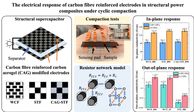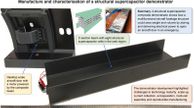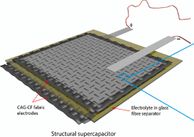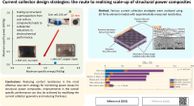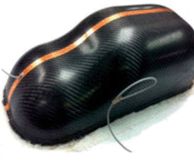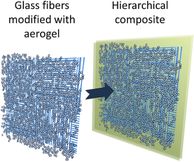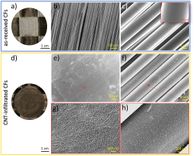Highlights
This is a selection of publications from the Structural Power Composites Group. For a full list of publications, please see below.
Highlights
Results
- Showing results for:
- Reset all filters
Search results
-
Conference paperAnthony D, Nguyen S, Senokos E, et al., 2019,
Hierarchical carbon aerogel modified carbon fiber composites for structural power applications
, 22nd International Conference on Composite Materials 2019 (ICCM22), Publisher: Engineers Australia, Pages: 1-7The desire to reduce overall weight in devices is a key driver for perpetual material development; the ability to combine composites with energy storage functions/capabilities which simultaneously provide structural integrity has the potential to supersede monofunctional components. To achieve this ambition, the multifunctional structure must perform both mechanical and energy storage functions sufficiently, but often there is a trade off in performance which is a significant challenge to overcome. Carbon aerogels have been shown to contribute positively to (electro-chemical double layer) capacitive performance due to an increased surface area in multifunctional carbon fiber based composite electrodes, but have also been shown to reduce mechanical properties; the addition of nanoscale reinforcers, such as carbon nanotubes, graphene or alike, with their superlative electrical and mechanical properties are proposed to address these concerns and create a truly hierarchical structure suitable for structural power applications.
-
Conference paperLee C, Panesar A, Greenhalgh E, 2019,
Design of optimised multi-scale structures for multifunctional composites
, International conference on composite materials (ICCM-22), Publisher: Engineers Australia, Pages: 1-8The multi-scale structures are commonly found in nature, such as plants and bones. Such multi-scale structurescan be divided into macro-scale, micro-scale and further sub-scale structures. In this study, we aim to designoptimised two-scale structures for multifunctional composites, specifically by enhancing the structural stiffnessand the ionic conductivity simultaneously. To tackle this problem, a novel strategy for achieving optimised multiscale structures is presented. A database of optimised micro-scale structures and simple placement criterion forthe micro-scale structure were applied. We demonstrate the efficiency of our strategy by designing, optimisingand evaluating two-scale structures composed of macro-and micro-scales. The advantage of our strategy foroptimised multi-scale structures is presented and discussed by comparing the structural stiffness and the ionicconductivity of several two-scale structures composed of different microstructures such as the solid-void, uniformand varied microstructures.
-
Journal articleJavaid A, Ho KKC, Bismarck A, et al., 2018,
Improving the multifunctional behaviour of structural supercapacitors by incorporating chemically activated carbon fibres and mesoporous silica particles as reinforcement
, JOURNAL OF COMPOSITE MATERIALS, Vol: 52, Pages: 3085-3097, ISSN: 0021-9983 -
Conference paperAnthony DB, bismarck A, blaker JJ, et al., 2016,
Development of novel composites through fibre and interface/interphase modification
, 37th Risø International Symposium on Materials Science, Publisher: IOP, Pages: 012001-012001, ISSN: 1757-8981We show how fibre/matrix interface (or interphase) modification can be used to develop a range of novel carbon fibre reinforced polymer (CFRP) composites that open up new applications far beyond those of standard CFRPs. For example, composites that undergo pseudo-ductile failure have been created through laser treatment of carbon fibres. Composites manufactured with thermo-responsive interphases can undergo significant reductions in stiffness at elevated temperatures. Additionally, structural supercapacitors have been developed through a process that involves encapsulating carbon fibres in carbon aerogel.
-
Journal articleJavaid A, Ho KKC, Bismarck A, et al., 2015,
Carbon fibre-reinforced poly(ethylene glycol) diglycidylether based multifunctional structural supercapacitor composites for electrical energy storage applications
, Journal of Composite Materials, Vol: 50, Pages: 2155-2163, ISSN: 1530-793X -
Conference paperQian H, Nguyen S, Anthony DB, et al., 2015,
Stiff monolithic aerogel matrices for structural fibre composites
, 20th International Conference on Composite Materials, Publisher: iccm-central.orgResorcinol-formaldehyde based aerogel precursors were infused into structural carbon fibreweaves, then gelled and carbonised to generate a continuous monolithic matrix network. Thishierarchical carbon preform was subsequently infused with polymeric resins, both multifunctional andstructural, to produce dense composites. The resulting hierarchical composites have a nanoscalereinforcement in the matrix at up to an order of magnitude higher loadings than typically available byother techniques. Compression, tension, ±45° shear and short beam tests demonstrate the potential ofsuch matrix systems to address matrix dominated failures. However, for the best structuralperformance it will be necessary to re-optimise the fibre-matrix interface, which is degraded by thecurrent processing regime.
-
Book chapterAsp LE, Greenhalgh ES, 2015,
Multifunctional structural battery and supercapacitor composites
, Multifunctionality of Polymer Composites: Challenges and New Solutions, Pages: 619-661This chapter introduces the concept of structural power composite materials and their possible devices. Carbon fibers are used as reinforcement and electrode in polymer composites, where the polymer is ion conductive, exploiting their electrochemical and conductive capabilities in concert with their excellent mechanical properties. By this approach engineering materials with an electrical energy storing ability emerge-structural batteries and supercapacitors.First a brief overview of the state-of-the-art, highlighting achievements related to structural battery and supercapacitor devices, is presented. The research areas addressed for the two types of material devices include carbon fiber electrodes, structural separators, multifunctional matrix materials, device architectures, and material functionalization. Following this, engineering issues such as multifunctional design methods, connectivity, finishing, crashworthiness, and demonstration are discussed in detail. The chapter culminates in a detailed description of engineering challenges that call for further research.
-
Conference paperGreenhalgh ES, Shirshova N, Kucernak A, et al., 2015,
RECENT ADVANCES IN STRUCTURAL SUPERCAPACITORS FOR TRANSPORT APPLICATIONS
, 20th International Conference on Composite Materials (ICCM), Publisher: AALBORG UNIV PRESS- Author Web Link
- Cite
- Citations: 1
-
Journal articleShirshova N, Qian H, Houlle M, et al., 2014,
Multifunctional structural energy storage composite supercapacitors
, Faraday Discussions, Vol: 172, Pages: 81-103, ISSN: 1359-6640This paper addresses the challenge of producing multifunctional composites that can simultaneously carry mechanical loads whilst storing (and delivering) electrical energy. The embodiment is a structural supercapacitor built around laminated structural carbon fibre (CF) fabrics. Each cell consists of two modified structural CF fabric electrodes, separated by a structural glass fibre fabric or polymer membrane, infused with a multifunctional polymeric electrolyte. Rather than using conventional activated carbon fibres, structural carbon fibres were treated to produce a mechanically robust, high surface area material, using a variety of methods, including direct etching, carbon nanotube sizing, and carbon nanotube in situ growth. One of the most promising approaches is to integrate a porous bicontinuous monolithic carbon aerogel (CAG) throughout the matrix. This nanostructured matrix both provides a dramatic increase in active surface area of the electrodes, and has the potential to address mechanical issues associated with matrix-dominated failures. The effect of the initial reaction mixture composition is assessed for both the CAG modified carbon fibre electrodes and resulting devices. A low temperature CAG modification of carbon fibres was evaluated using poly(3,4-ethylenedioxythiophene) (PEDOT) to enhance the electrochemical performance. For the multifunctional structural electrolyte, simple crosslinked gels have been replaced with bicontinuous structural epoxy–ionic liquid hybrids that offer a much better balance between the conflicting demands of rigidity and molecular motion. The formation of both aerogel precursors and the multifunctional electrolyte are described, including the influence of key components, and the defining characteristics of the products. Working structural supercapacitor composite prototypes have been produced and characterised electrochemically. The effect of introducing the necessary multifunctional resin on the mechanical properties
-
Journal articleShirshova N, Bismarck A, Greenhalgh ES, et al., 2014,
Composition as a Means To Control Morphology and Properties of Epoxy Based Dual-Phase Structural Electrolytes
, JOURNAL OF PHYSICAL CHEMISTRY C, Vol: 118, Pages: 28377-28387, ISSN: 1932-7447- Author Web Link
- Cite
- Citations: 48
-
Journal articleGreenhalgh ES, Ankersen J, Asp LE, et al., 2014,
Mechanical, electrical and microstructural characterisation of multifunctional structural power composites
, Journal of Composite Materials, Vol: 49, Pages: 1823-1834, ISSN: 1530-793X -
Journal articleAsp LE, Greenhalgh ES, 2014,
Structural power composites
, COMPOSITES SCIENCE AND TECHNOLOGY, Vol: 101, Pages: 41-61, ISSN: 0266-3538- Author Web Link
- Cite
- Citations: 206
-
Journal articleJavaid A, Ho KKC, Bismarck A, et al., 2014,
Multifunctional structural supercapacitors for electrical energy storage applications
, JOURNAL OF COMPOSITE MATERIALS, Vol: 48, Pages: 1409-1416, ISSN: 0021-9983- Author Web Link
- Cite
- Citations: 51
-
Journal articleQian H, Kucernak AR, Greenhalgh ES, et al., 2013,
Multifunctional Structural Supercapacitor Composites Based on Carbon Aerogel Modified High Performance Carbon Fiber Fabric
, ACS APPLIED MATERIALS & INTERFACES, Vol: 5, Pages: 6113-6122, ISSN: 1944-8244- Author Web Link
- Cite
- Citations: 183
-
Journal articleQian H, Diao H, Shirshova N, et al., 2013,
Activation of structural carbon fibres for potential applications in multifunctional structural supercapacitors
, JOURNAL OF COLLOID AND INTERFACE SCIENCE, Vol: 395, Pages: 241-248, ISSN: 0021-9797- Author Web Link
- Cite
- Citations: 72
-
Conference paperMistry M, Kucernak A, Nguyen S, et al., 2013,
Addressing engineering issues for a composite structural power demonstrator
, Pages: 2692-2700Engineering issues have been addressed for a Multifunctional (MF) Carbon Fibre Reinforced Polymer (CFRP) capable of storing electrical energy and carrying mechanical load. The MF material was integrated into a technology demonstrator in the form of a car boot lid where the boot lighting was powered independently of the car main electrical system. Current collection was improved by using a thin copper mesh on the carbon electrodes while hole drilling was found to have a negligible effect on the laminate electrical performance.
-
Conference paperQian H, Kucernak AR, Greenhalgh ES, et al., 2013,
Multifunctional structural power composites based on carbon aerogel modified high performance carbon fibre fabrics
, Pages: 2238-2243- Cite
- Citations: 6
-
Conference paperShirshova N, Bismarck A, Carreyette S, et al., 2013,
Correlations between mechanical properties and ionic conduction of structural electrolytes with bicontinuous morphologies
, Pages: 72-79- Cite
- Citations: 3
-
Conference paperGreenhalgh ES, Ankersen J, Asp LE, et al., 2013,
Mechanical and microstructural characterisation of multifunctional structural power composites
, Pages: 2228-2237- Cite
- Citations: 1
-
Journal articleShirshova N, Bismarck A, Carreyette S, et al., 2013,
Structural supercapacitor electrolytes based on bicontinuous ionic liquid-epoxy resin systems
, JOURNAL OF MATERIALS CHEMISTRY A, Vol: 1, Pages: 15300-15309, ISSN: 2050-7488- Author Web Link
- Cite
- Citations: 118
This data is extracted from the Web of Science and reproduced under a licence from Thomson Reuters. You may not copy or re-distribute this data in whole or in part without the written consent of the Science business of Thomson Reuters.
Related links
Contact
Professor Emile S Greenhalgh
Department of Aeronautics
Imperial College London
South Kensington Campus
London SW7 2AZ
+44 (0)7958 210 089
e.greenhalgh@imperial.ac.uk
